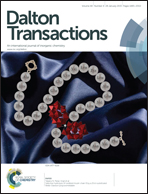Cyclometallated platinum(ii) complexes of benzylidene-2,6-di-isopropylphenylamine containing bidentate phosphines: synthesis, structural properties and reactivity studies†
Abstract
The reaction of the cyclometallated complex [PtCl(N^C)(dmso)], 1 (N^C represents the cyclometallated Schiff base, benzylidene-2,6-diisopropylphenylamine), with 1,1′-bis(diphenylphosphino)ferrocene, dppf, bis(diphenylphosphino)methane, dppm, or 1,2-bis(diphenylphosphino)ethane, dppe, in a 2 : 1 ratio or an equimolar ratio using acetone as the solvent produced the corresponding binuclear or mononuclear diphosphine platinum complexes. In the case of the mononuclear complexes, the diphosphines act as either a bidentate ligand or a monodentate ligand depending on the size of the bite angle of the diphosphines, while in the case of the binuclear complexes, the diphosphines act as a bridging ligand between the two metal centres. The solid state structures of some of the binuclear as well as mononuclear species are reported. The mononuclear derivatives were found to show different behaviour in solution and in the solid state when compared to the binuclear analogues. This behaviour is also influenced by the nature of the diphosphine ligands employed.


 Please wait while we load your content...
Please wait while we load your content...